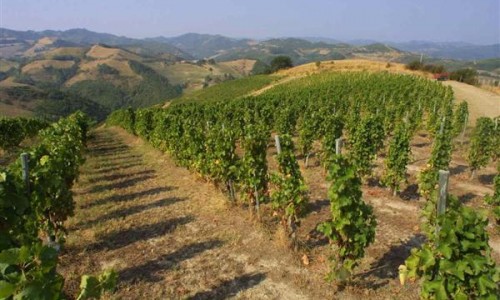





Emilia Romagna

|
It’s hard to have a precise idea about Emilia Romagna, because you get so many conflicting impressions. Speaking about the landscape, this is perhaps one of the most boring regions in Italy, since a large part of it consists of flat and monotonous Po river valley, as you can see especially on the motorway from Verona towards Ancona. But when you mention some of the products which are made here, the region is far from boring. On the contrary, Emilia-Romagna, is home to some of the highest quality products that Italy can offer: Parmesan cheese is an essential seasoning in a large number of Italian dishes; the balsamic vinegar from Modena, which – after it has been known outside of Italian borders – has set new standards for vinegar, and Parma ham. And then in this context you might ask: where does Emilia-Romagna stand, purely from a wine point of view? Can the wines live up to those three culinary gems? One must be keenly patriotic to say that Lambrusco has the quality to do that, and the wine has also proven not to be quite as successful and sustainable in the export markets as the cheese, the vinegar and the ham. But that being said, one should not underestimate the Lambrusco: a ‘sweet bubbling wine’. Lambrusco, which can be made from several different varieties of the grape Lambrusco, each with a different area of origin, is a slightly sparkling and foaming wine, and it is found in different levels of sweetness. Lambrusco is a very local phenomenon but for the exception of the many Auto-grills, located on the Italian motorways. Here you will find Lambrusco, in the often limited wine selection, but it appears as an excellent companion for a quick lunch with a salad and a plate of sausages and ham, a quick pasta or a pizza. Is this speaking evil of the wine? On the contrary, it shows that it is the answer to a practical problem when you are hungry and thirsty and there is a 50 km detour to the nearest decent trattoria. Lambrusco has, despite the recognition of several DOCs, not yet been found worthy to be appointed to a DOCG, and there are probably many who would be surprised if this happened. It was the same in 1987, when Albana di Romagna was given the DOCG. Nobody had imagined that this great unknown wine would become the first Italian white wine with the DOCG status, but it was, then. Now, 25 years after, the wine has become better known outside of Romagna. The best versions are made as Passito wines, but it exists in varying degrees of sweetness without appassimento, as well as dry. It’s also in the Romagna part of the region that you will find the most recent and important wine-related innovation, namely the DOC Sangiovese di Romagna. |
|
||||||||||||||||